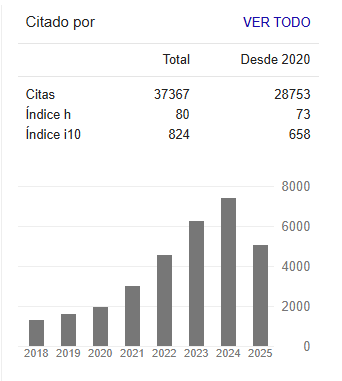Análisis estructural de los factores que inciden en el emprendimiento
Resumen
Esta investigación tuvo como objetivo determinar los factores que inciden en el emprendimiento mediante un análisis estructural en los graduados de las carreras empresariales de la ciudad de Quito. La metodología a utilizar en esta investigación fue el método deductivo, el alcance del estudio fue descriptivo porque está orientado a determinar los factores que inciden en el emprendimiento, mediante un modelo estructural en los graduados de las carreras empresariales. Los factores que inciden en la creación de un negocio son: transferencia de investigación y desarrollo, educación y capacitación en emprendimiento, normas culturales y sociales. Se concluye que la educación y capacitación en emprendimiento, y la transferencia de investigación y desarrollo no tienen una influencia directa y significativa en la capacidad de crear un nuevo negocio.
Citas
Brown, T. (2015). Confirmatory factor analysis for applied research. (Second ed.). The Guilford Press.
Clarysse, B., Tartari, V., & Salter, A. (2011). The impact of entrepreneurial capacity, experience and organizational support on academic entrepreneurship. Research Policy, 40(8), 1084-1093. https://doi.org/10.1016/j.respol.2011.05.010
Cooper, S., & Park, J. (2008). The Impact of `Incubator’ Organizations on Opportunity Recognition and Technology Innovation in New, Entrepreneurial High-technology Ventures. International Small Business Journal, 26(1), 27-56. https://doi.org/10.1177/0266242607084658
Chion, S., & Charles, V. (2016). Analítica de datos para la modelación estructural. Pearson.
DeTienne, D., & Chandler, G. (2004). Opportunity Identification and Its Role in the Entrepreneurial Classroom: A Pedagogical Approach and Empirical Test. Academy of Management Learning & Education, 3(3), 242-257. https://doi.org/10.5465/AMLE.2004.14242103
Díaz-Casero, J., Hernández-Mogollón, R., & Roldán, J. (2012). A Structural Model of the Antecedents to Entrepreneurial Capacity. International Small Business Journal, 30(8), 850-872. https://doi.org/10.1177/0266242610385263
Díaz-Casero, J., Hernández, R., Sánchez, M., & Postigo Jiménez, M. (2010). Actividad emprendedora y género: Un estudio comparativo. Revista Europea de Dirección y Economía de la Empresa, 19(2), 83-98.
Díaz-Casero, J., Urbano Pulido, D., & Hernández-Mogollón, R. (2005). Teoría económica institucional y creación de empresas. Investigaciones Europeas de Dirección y Economía de la Empresa, 11(3), 209-230.
Garson, D. (2016). Partial least squares: Regression & structural equation models. Asheboro: Statistical Associates Blue Book Series.
George, G., & Zahra, S. (2002). Culture and Its consequences for entrepreneurship. Entrepreneurship: Theory and Practice, 26(4), 5-9.
Gibb, A., & Hannon, P. (2006). Towards the entrepreneurial university. International Journal of Entrepreneurship Education, 5(1), 73-110.
Hair, J., Hult, T., Ringle, C., & Sarstedt, M. (2014). A premier on partial least squares structural equation modeling (PLS-SEM). Los Angeles: SAGE.
Henry, C., Hill, F., & Leitch, C. (2005). Entrepreneurship education and training: can entrepreneurship be taught? Part I. Education+Training, 47(2), 98-111.
Hernández, R., Fernández, C., & Baptista, P. (2014). Metodología de la investigación. (6ta edición). McGraw Hill.
Hofstede, G. (1980). Culture’s Consequences: International Differences in Work-Related Values. Beverly Hills, Calif: Sage Publications.
Honig, B. (2004). Entrepreneurship education: Toward a model of contingency-based business planning. Academy of Management Learning & Education, 3(3), 258-273. https://doi.org/10.5465/AMLE.2004.14242112
Knight, F. (1964). Risk, uncertainty and profit. Sentry Press.
Kwong, K., & Kay, W. (2013). Partial least squares structural equation modeling (PLS-SEM) techniques using SmartPLS. Marketing Bulletin, 24(1), 1-32.
Leibenstein, H. (1968). Entrepreneurship and development. The American Economic Review, 58(2), 72-83.
Levie, J., & Autio, E. (2008). A theoretical grounding and test of the GEM model. Small Business Economics, 31(3), 235-263. https://doi.org/10.1007/s11187-008-9136-8.
Nelson, R., & Winter, S. (1982). An Evolutionary Theory of Economic Change. Cambridge, Mass.: The Belknap Press of Harvard Univ. Press.
Nicolaou, N., Shane, S., Cherkas, L., & Spector, T. (2009). Opportunity recognition and the tendency to be an entrepreneur: A bivariate genetics perspective. Organizational Behavior and Human Decision Processes, 110(2), 108-117. https://doi.org/10.1016/j.obhdp.2009.08.005
Otani, K. (1996). A Human Capital Approach to Entrepreneurial Capacity. Economica, New Series, 63(250), 273-289.
Peterman, N., & Kennedy, J. (2003). Enterprise education: Influencing students’ perceptions of entrepreneurship. Entrepreneurship Theory and Practice, 28(2), 129-144. https://doi.org/10.1046/j.1540-6520.2003.00035.x
Ringle, C., Sarstedt, M., y Straub, D. (2012). Editor’s comments: a critical look at the use of PLS-SEM in MIS quarterly. Quarterly, 36(1), iii-xiv. https://doi.org/10.2307/41410402
Reynolds, P., Bosma, N., Autio, E., Hunt, S., De Bono, N., Servais, I., … Chin, N. (2005). Global Entrepreneurship Monitor: Data collection design and implementation 1998 - 2003. Small Business Economics, 24(3), 205-231. https://doi.org/10.1007/s11187-005-1980-1
Schumpeter, J. (1934). The Theory of Economic Development: An Inquiry into Profits, Capital, Credit, Interest, and the Business Cycle. Harvard University Press.
Shane, S. (2000). Prior knowledge and the discovery of entrepreneurial opportunities. Organization Science, 11(4), 367-472.
Smith, P., Peterson, M., & Schwartz, S. (2002). Cultural values, sources of guidance, and their relevance to managerial behavior: A 47 - nation study. Journal of Cross-Cultural Psychology, 33(2), 188-208. https://doi.org/10.1177/0022022102033002005
Thornton, P., Ribeiro-Soriano, D., & Urbano, D. (2011). Socio-cultural factors and entrepreneurial activity: An overview. International Small Business Journal: Researching Entrepreneurship, 29(2), 105-118. https://doi.org/10.1177/0266242610391930
Wong, K. (2016). Technical note: Mediation analysis, categorical moderation analysis, and higher-order constructs modeling in partial least squares structural equation modeling (PLS-SEM): A B2B example using SmartPLS. The Marketing Bulletin, 26(1), 1-23








.png)






























